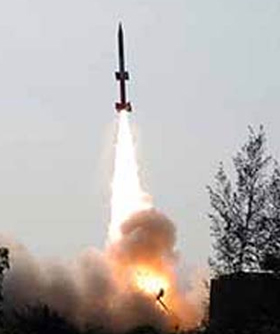ISRO Successfully Tests Scramjet Engine, Could Make Future Launches Cheaper
www.mangaloretoday.com
Chennai, August 28, 2016: India on Sunday morning successfully tested its own scramjet or the air breathing engine with the launch of a big sounding rocket, said a senior official of Indian Space Research Organisation (ISRO). "The mission was successful. Two scramjet engines were tested during the flight. The finer details about the test will be known later," the official not wanting to be quoted told IANS.
"The mission was successful. Two scramjet engines were tested during the flight. The finer details about the test will be known later," the official not wanting to be quoted told IANS.
He said that as scheduled the two stage/engine RH-560 sounding rocket took off from the rocket port located at Satish Dhawan Space Centre (SDSC) in Sriharikota in Andhra Pradesh.
He said the two air breathing engines were like hugging the rocket on its sides and normally when the rocket reaches a height of 11 km the scramjet engines would start breathing air.
"The scramjet engines were ignited 55 seconds into the rocket’s flight. The engines were tested for six seconds," he added.
The scramjet engine, used only during the atmospheric phase of the rocket’s flight, will help in bringing down the launch cost by reducing the amount of oxidiser to be carried along with the fuel.
Later, the ISRO in a statement said: "With this flight, critical technologies such as ignition of air breathing engines at supersonic speed, holding the flame at supersonic speed, air intake mechanism and fuel injection systems have been successfully demonstrated."
The scramjet engine designed by ISRO uses hydrogen as fuel and the oxygen from the atmospheric air as the oxidiser.
The test flight was the maiden short duration experimental test of ISRO’s scramjet engine with a hypersonic flight at Mach 6.
ISRO’s Advanced Technology Vehicle (ATV), which is an advanced sounding rocket, was the solid rocket booster used for testing the air breathing engine.
The rocket weighed 3,277 kg during lift-off.
According to ISRO, some of the technological challenges handled by ISRO during the development of scramjet engine include the design and development of hypersonic engine air intake, the supersonic combustor, development of materials withstanding very high temperatures, computational tools to simulate hypersonic flow, ensuring performance and operability of the engine across a wide range of flight speeds, proper thermal management and ground testing of the engines.
"India is the fourth country to demonstrate the flight testing of scramjet engine. The successful technology demonstration of air-breathing scramjet engines in flight by ISRO is a modest yet important milestone in its endeavour to design and develop advanced air breathing engines including engines for ISRO’s future space transportation system," the space agency added.
- Mangaluru: Woman gang-raped near Netravati river, auto driver among three arrested
- Kukke Subrahmanya temple retains title as Karnataka’s richest temple with Rs 155.95 crore annual revenue
- Karnataka HC orders crackdown on clinics run by ’unqualified doctors’
- Karnataka relaxes age rule for class 1 admission to 5.5 Years for 2025-26 academic year
- Bantwal: Rider dies as scooter falls into drain
- Bantwal: Mobile shop owner attacked with machete
- Mangaluru: CCB cops arrest drugs peddler at Lalbagh; seize MDMA
- Police ask motorists to avoid the Padil–B.C. Road stretch of NH75 on April 18
- Exploring Careers in Pharmacy: Opportunities and Programs at NGSMIPS
- Auto-rickshaw collides with container truck at Brahmavar black spot; several injured
- Confederation questions rise in castes under SC/ST communities
- District in-charge Secretary calls for more measures to encourage start-ups
- Over 30,000 students to write CET in DK, Udupi for two days from today
- India slams Pakistan Army chief’s remarks: ‘Kashmir’s only relation with Pak is…’
- Removal of sacred thread at CET centre in Shivamogga triggers row
- JD Vance, wife Usha to visit India from April 21-24, hold talks with PM Modi
- 22 Naxalites arrested, explosives seized in Chhattisgarh
- CRPF ’backbone’ of mission to rid country of Naxalism by March 2026: Amit Shah
- BJP likely to get new chief by April-end as state-level polls conclude: Sources
- No end in sight to Karnataka lorry strike, essential items may become costlier
- Supreme Court considers interim stay on parts of waqf act, centre pushes back
- CJI Sanjiv Khanna names Justice B R Gavai as successor
- Supreme Court hears multiple pleas challenging waqf (Amendment) act
- Tree felling near University of Hyderabad: SC halts deforestation till next hearing
- Autorickshaw driver crushed to death after metro viaduct falls on vehicle in Bengaluru
- Skills and Competencies Take Center Stage at MSN Dialogue Series
- Court remands Maoist Lakshmi to six-day police custody
- Sandhya Shenoy honored with Society for Materials Chemistry Medal-2024
- White Cornus Apartment in Mangaluru
- City girl wins first place in state-level spell bee competition
- Alleged ‘Love Jihad’ Case in Mangaluru: Woman left home voluntarily, says police
- Girl fatally struck by reckless two-wheeler near Belman
- New residential complex for the judges inaugurated in Mangaluru
- Absconding accused nabbed after 8 years
- Truck with cylinders turns turtle in Beltangady
- Bhoota Kola artist dies of cardiac arrest
- Development of the country should be our goal: Ganesh Karnik
- Container truck gets stuck under Modankap railway bridge
- Truck crushes bike’s pillion rider near BC Road
- Head constable dies of heart attack
- CITY INFORMATION
- TRAVEL
- TOURIST INFORMATION
- HEALTH CARE
- MISCELLANEOUS




 Write Comment
Write Comment E-Mail To a Friend
E-Mail To a Friend Facebook
Facebook Twitter
Twitter  Print
Print 


